- Open today, noon to 5 pm.
- Parking & Directions
- Free Admission
Artist Feature: Alyssa Pickens
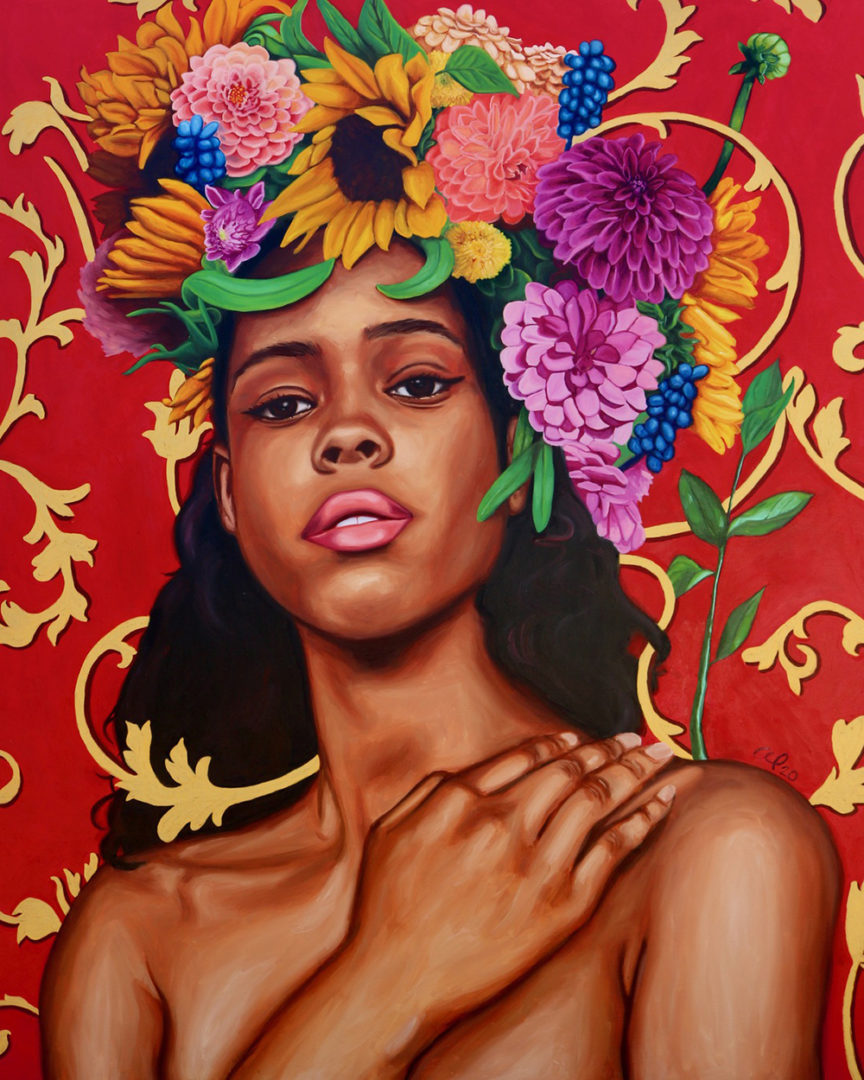
A larger-than-life composition in red and gold made a glorious statement in Light From All Sides, an exhibition on view earlier this year at the Downing Gross Cultural Arts Center. The stunning portrait by Alyssa Pickens brims with emotion and elegance and evokes the work of Kehinde Wiley and John Singer Sargent with freshly rendered cascades of flowers. Pickens, a Newport News native and graduate of Christopher Newport University, focuses her lens on portraits of men and women of color in order to counteract often aggressive and hypermasculine media representations of Black Americans. By adorning her subjects with floral crowns and working in a sumptuous jewel-toned palette, she presents them in a state of both elevation and vulnerability that resonates with collectors across the globe.
Pickens recently spent a morning touring the Chrysler Museum with Gallery Host Jennifer Hand. Their conversation touched on issues of representation, truth in materials, and influences throughout art history.
Jennifer Hand: How familiar are you with the Chrysler collection? Are you a frequent visitor during normal times?
Alyssa Pickens: Before the pandemic, I was definitely here a lot, especially when you guys were open late for events. Something about coming to a museum at night is just so much nicer than going to a bar!
JH: Do you have a favorite section to visit?
AP: The purple room upstairs with the Sargent piece and the vertical portraits—that’s my favorite.
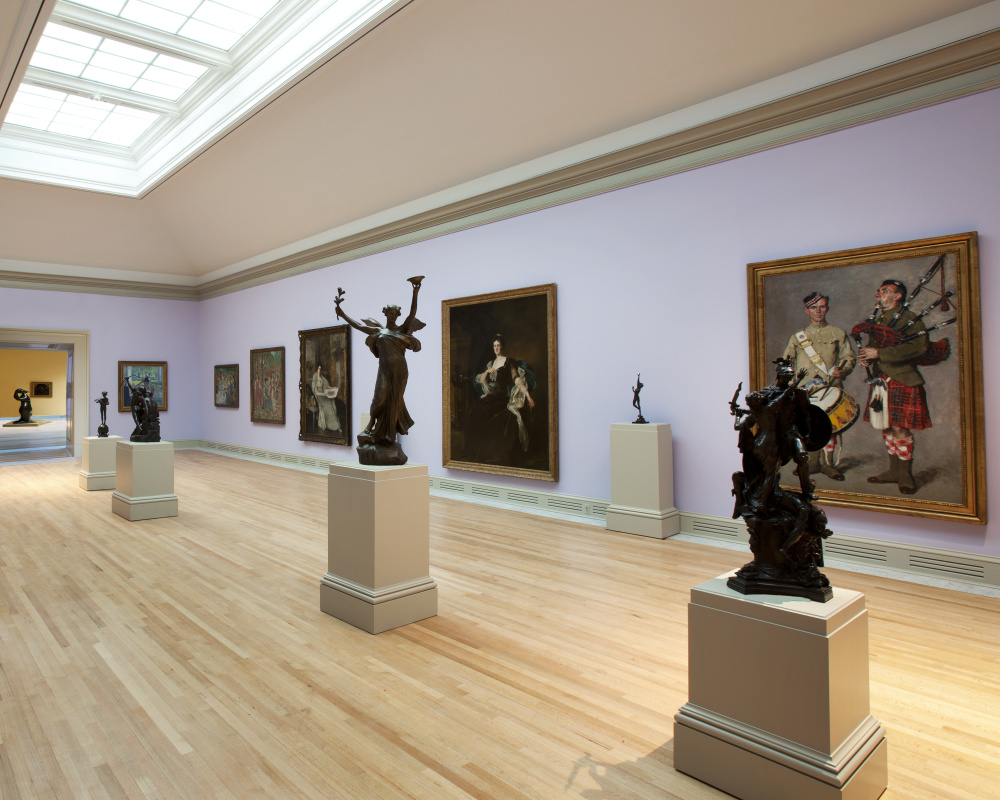
American Impressionist Gallery, Gallery 218
JH: I know where we’re starting then!
Pickens and Hand head upstairs, admiring the Sam Gilliam’s Norfolk Keels in Huber Court. “Every time I see it, I think of Monet!” Pickens said. Once upstairs, Susan Watkins’s Marguerite was their first stop.
AP: I love how paintings in this time evolved from only painting royalty and people who were super important to showing everyday life and everyday people. It’s actually funny that you stopped in front of this one because it’s my favorite in this room.
Pickens gestures to Marguerite’s white dress.

Susan Watkins (American, 1875–1913), Marguerite, ca. 1906, Oil on canvas, Bequest of Goldsborough Serpell, 46.76.146
AP: Nothing’s ever really white when you paint. Just look at how she translates all the purples and the browns, and you can still tell that it’s white. Her posture, too, is so delicate. And her hands—I love her hands.
JH: Watkins skirted a line of making them otherworldly with how narrow the fingers are, but the risk paid off in the effect of the gesture.
AP: I don’t know what it is about hands that I like. They have a language of their own; I can’t explain it. For a painter, there’s either hands or Cheetos. There’s nothing in between!
Both laugh and then turn to William Merritt Chase’s Portrait of Susan Watkins.

William Merritt Chase (American, 1849-1916), Portrait of Susan Watkins, ca. 1914, Oil on canvas, Goldsborough Serpell Bequest, 46.76.159
JH: As a portraitist, how does this piece strike you?
AP: I just love impressionism so much because it teeters in between realism and the abstract. I love the fact that you can see brushstrokes, which is funny because I don’t like to have a lot of brushstrokes showing in my works. So, it’s funny that I’m so drawn to this kind of work.
JH: There’s a looseness and a freedom here, but it’s disciplined.
AP: It’s very controlled. She stands out a lot. You can tell she’s the anchor—she’s the subject because she’s the brightest thing in the portrait. But the more you look, the more you can get a narrative from the rest of the portrait.
Hand leads them to Cassatt’s The Family to discuss the European impressionists.
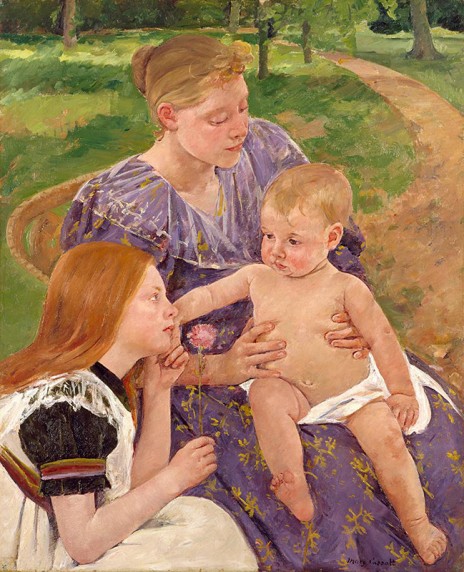
Mary Cassatt American, (active France, 1844–1926), The Family, ca. 1892, Oil on canvas, Gift of Walter P. Chrysler, Jr. 71.498
JH: This piece isn’t necessarily a portrait, but a portrait of a family. The use of pattern and flowers here really reminds me of your work.
AP: I really like Mary Cassatt’s focus on ordinary people and ordinary moments, and her work is so motherly and feminine. Look at her gentle grasp on the baby right there.
JH: The pudgy baby roll coming through the fingers—it’s always been so funny to me as an artist and mother to see the tenderness with which she renders motherhood, given the fact that Cassatt herself never had children.
AP: I wonder where she got that from! I don’t have children, so I can’t picture myself painting and truly connecting with motherhood so successfully like she does.
Pickens steps over to Renoir’s Daughters of Durand-Ruel.
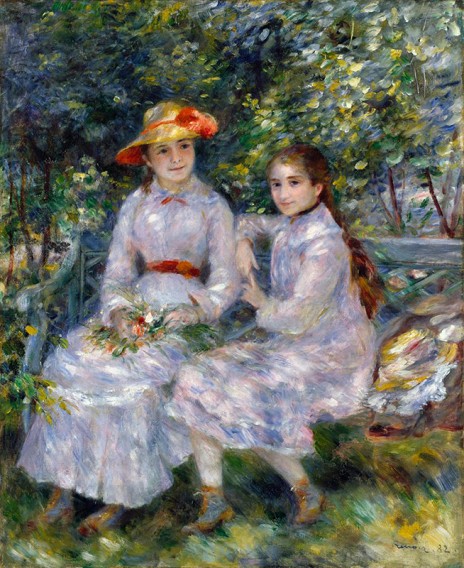
Pierre-Auguste Renoir (French, 1841–1919), The Daughters of Durand-Ruel, 1882, Oil on canvas, Gift of Walter P. Chrysler, Jr., in memory of Thelma Chrysler Foy, 71.518
AP: I usually stop here, too. I just love the lighting through the trees and how it translates into so many colors on the white dresses.
Hand steers them toward the contemporary galleries.
JH: What are your feelings on modern and contemporary art?
AP: I’m warming up to it! I’m more open to it now than I once was.
Hand and Pickens stop in front of Titus Kaphar’s Michael Brown.
JH: This one came on view pretty recently. It’s a pretty challenging work. The way that it talks about vulnerability and representation is very powerful and very reminiscent of your work and especially your artist statement.
AP: I love Titus Kaphar’s work so, so much. The layered portraits make this very disorienting. It’s almost as if Kaphar wanted you to step back and see the issue of police brutality as a whole. I can really appreciate how he takes certain elements from events and uses them to shift your perspective.”
Pickens takes a minute to study the label copy referencing Kaphar’s choice of materials.
AP: Reading about his choice to use chalk in reference to crime scenes—wow. I connect to this piece because my work stemmed from Michael Brown’s death.
Pickens pauses and draws a deep breath.
AP: I… I don’t even know what to say. I just love his work so much.
Hand and Pickens walk past Wangechi Mutu’s Throne.

JH: This piece is one of the best conversation starters in the whole museum!
AP: Yes, I can see why! What is this?
JH: This sculpture is also a time-based piece; Mutu intends for this to drip wine and change over time. I just love the fact that she’s emphatically taking up space as a woman artist of color and breaking the most sacred of all museum rules: No wine in the galleries!
Pickens laughs.
AP: Okay, I love a good wine night!
Hand and Pickens inspect Floor Hole by Ivan Navarro, a work on loan to the Chrysler Museum.
AP: This is kind of scary to me!
JH: Right? The scariest thing about this infinity mirror is that kids seem to really want to climb onto it.
AP: Something about this disturbs me—the fact that it goes down forever. When you say infinity mirror, the first thing I think of is Yayoi Kusama’s infinity rooms. But those are so beautiful and make you feel like you’re immersed in a different world. But this is just a hole in the ground, and it bothers me!
JH: I wonder if that’s what the artist wanted—to make the viewer uneasy, to contemplate your own mortality?
AP: Must be working!
Hand guides them to the more familiar territory of Gallery 205, which contains Kehinde Wiley’s St Andrew.

AP: I love where this painting is placed in the museum.
JH: Yes, he’s one of our “intervention” pieces, which are designed to trace the exploration of ideas across time.
AP: I found out about Wiley in a blog, “Top 10 Contemporary Artists to Follow” or something like that. I saw one of his portraits, but I thought it was a photograph, so at first I was dismissive. But then I realized it was a painting, and I was so impressed. This was back in 2014 after Michael Brown got shot and there were so many protests, and I just felt the need to paint depictions of myself and people that look like me in a more positive and feminine light. Kehinde’s paintings had a really big influence on that. I just love the floral patterns that he uses—the way that he incorporates his subjects with his background. Look at how the green background reflects a glow onto his white shoes. I just love it so much—the intertwined background and subjects.
JH: It’s the attention to detail for me.
Hand points at a slightly scandalous detail on the custom baroque frame and they both giggle.
AP: The hyperrealism and scale were the first things to catch my attention. When he had a show in Richmond a couple years back, you would turn the corner and see a giant 10′ x 10′ painting in your face like, ‘I’m here. I’m present.’ That’s what I love about his work.
JH: Have you had a chance to see his Rumors of War sculpture in person yet?
AP: Yeah! Again, with the scale, and it’s so amazing how he can paint and sculpt and do glasswork and it all looks so undeniably his.
JH: And then, of course, the recognition of being chosen to do a presidential portrait. Speaking of that, you also completed a beautiful portrait of former president Obama!
AP: Thank you! Yes, that was definitely inspired by his portrait. Kehinde and Obama are both very influential people in general but especially in my life. I felt like I needed to do some sort of tribute to them.
Hand guides them to the unsigned Portrait of Mary Marsh and Enslaved Servants.
JH: I love how this label copy references the subtle subversion happening in the background. These enslaved women were forced to cover their hair, so they made their hair coverings into a form of resistance.
AP: Even now there’s still controversy with Black women’s hair. You hear stories all the time: ‘I got fired because of my braids’ or of Black women not being allowed to have certain hairstyles in the military. It’s like, ‘This is just how my hair grows, I can’t control it!’ I use a lot of flowers as crowns in my work, but it ultimately is about hair. My hair is pretty important to me, and the journey I’ve gone through with my hair is part of my identity, so I get a sense that how they styled their hair is part of their identity, too.
JH: This seems like a great segue to talk about the hair-and-makeup obsessed Egyptians. Let’s head downstairs!
Pickens and Hand arrive in front of the statue of Sekhmet.
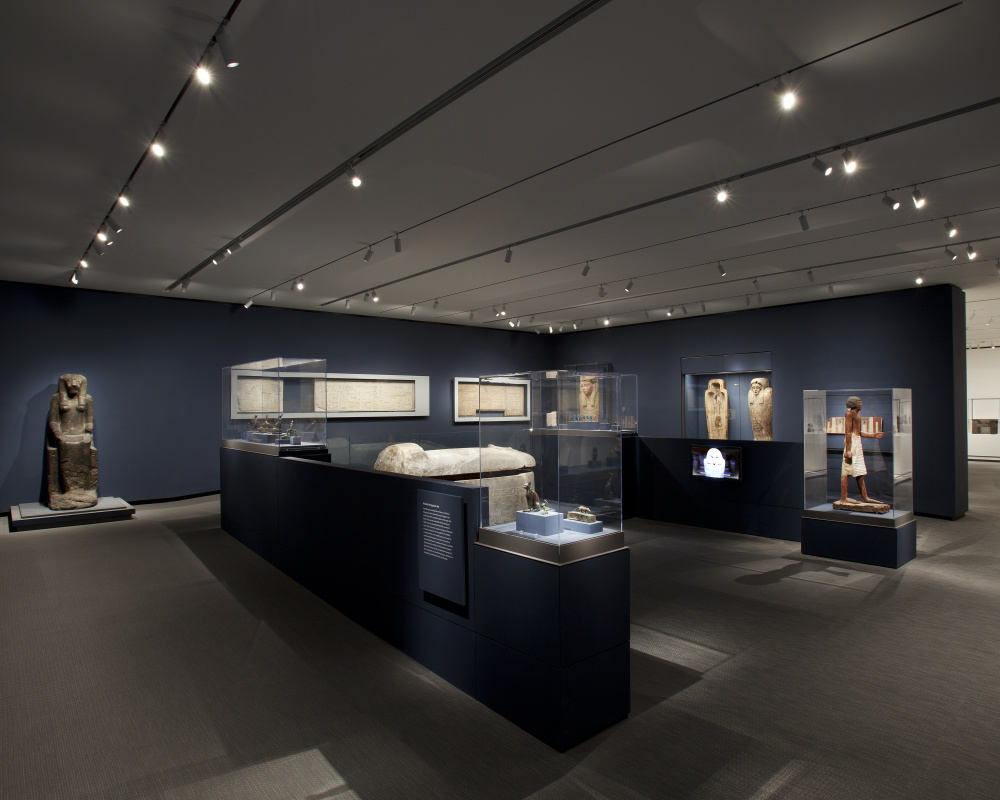
Ancient Worlds galleries, Gallery 109, Egyptian
JH: Sekhmet embodies so many themes I see in your work—not just the headdress, but her dualistic place in the Egyptian pantheon, being the goddess of both healing and of destruction.
AP: It’s beautiful. I love looking at work like this. I never really cared about ancient art until I went to Rome. The city is just layers of history, and you can see the Etruscans, the pagans, the Christians literally one on top of the other. It had such a huge effect on me. Now seeing something like this and hearing about the duality of masculine and feminine in that culture—that’s definitely something I strive for in my work.
JH: You can even think of the way Egyptians obsessed over makeup as an emphasis on self-care!
AP: My piece in Light From All Sides revolves around self-love and self-care. For that show, [curator and artist] Clayton Singleton gathered nine artists and gave us each different facets of love that remind us about our personal artwork. Mine was ‘love of self and becoming.’
JH: What a beautiful prompt.
AP: It’s fitting for me. It’s a portrait where the girl has her hand on her heart, and she has all these flowers on her head. I think the more I paint, the more extra I’m getting with the flowers. Eventually, the whole canvas will be covered with flowers and you’re just going to see eyes! She’s got her hand on her heart like she’s making a pledge towards herself, going back to the Susan Watkins piece upstairs with her hand on her chest.
JH: Yes, I can definitely see the resemblance!
AP: Something about that gesture is just so tender. I find self-love to be the most important form of love. Your relationship to yourself is the longest relationship you will ever have. You can’t detach yourself from your body. You can’t be another person. You have to do what you can to take care of yourself.
Pickens and Hand take a detour into the glass galleries.
JH: Earlier, we talked about representations of white in impressionist painting—how it’s never really white but all the colors of the reflected light—same here with crystal. Clear is never really clear, is it?
AP: I don’t know much about glass, but I do love the idea of taking something that should be functional and making it decorative, especially when I see florals in glass. There’s such a great reference to the delicacy of glass vs the delicacy of flowers. Like these [Tiffany Flowerform Vases]. They’re supposed to hold flowers, but now they are flowers, too!
Pickens comes to a stop in front of the Woodall Cameos.

Thomas Woodall (English 1849-1926), George Woodall (English, 1850-1925), Thomas Webb & Son, Stourbridge, England, The Intruders, ca. 1893, Blown, cased, acid-etched, and cameo-carved glass, Gift of Rebecca W. Hitt in memory of Billy Hitt and Museum purchase with the assistance of Mr. and Mrs. John S. Shannon, 99.19
AP: I love the florals in this, too!
JH: There’s a great parallel between cameo and portraiture.
AP: Right, how it is subtractive versus the additive process of painting. This process looks so hard. I can’t imagine doing this myself.
JH: Just grinding away at glass with a diamond—it doesn’t get much harder than that!
AP: It’s just incredible that it’s so delicate and at the same time so durable with these areas of translucence.
Hand stops in front of Zondlile Zondo’s I Hear My Father’s Cattle, There is Music in My Heart
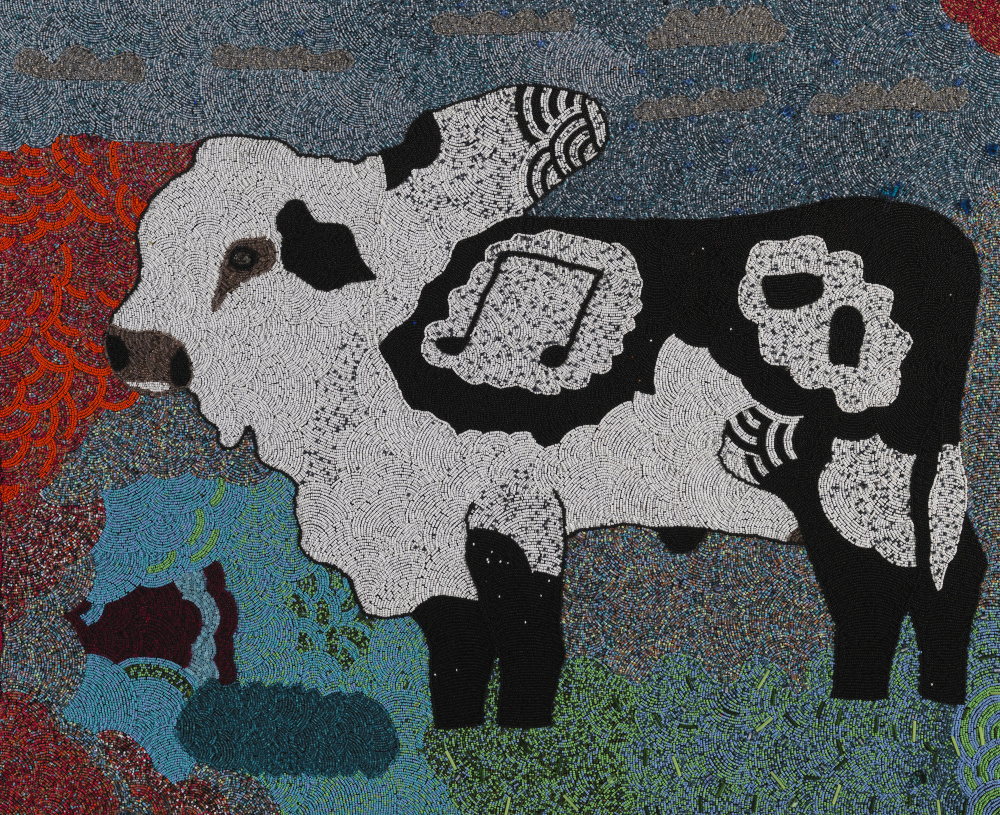
Zondlile Zondo (Zulu (South African), b. 1969), I Hear My Father’s Cattle, There is Music in My Heart, 2012, Czech glass beads on fabric, 2018.37.2
JH: These beadwork tapestries are another example of the time intensive nature of glass work: The scale, attention to detail, pattern.
AP: There’s a different feel when you’re far away versus close up and you can see each individual bead. You can tell there was a lot of love and work put into each one.
JH: Your portrait for Light From All Sides—that’s a large canvas; such a huge investment of time!
AP: Yes! Painting is a very long process, too. I love that part of the painting when you’re like, ‘Oh, I just worked for two hours on one flower petal.’ So, I can’t imagine how long this took.
JH: The patience
AP: There’s probably something therapeutic about it, too!
JH: Up until you spill the tray of beads!
Hand and Pickens laugh.
See Alyssa Pickens’s work at www.alyssachannelle.com and on Instagram @alyssa_channelle.

